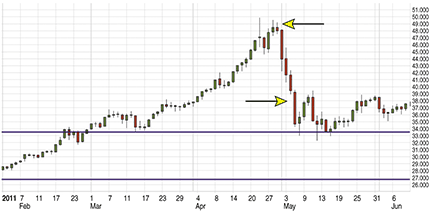AT THE CLOSE
When Worlds Collide...
...We all get smashed. Here’s how exchange traded funds caused the fallout in commodities.
In early May 2011, when commodity prices fell sharply after a long parabolic ascent, the trading world wagged its finger at the futures exchanges — the Chicago Mercantile Exchange (Cme) and Nymex, and so forth. Many of the investors who took losses in the pullback of silver, gold, and crude oil claimed that margin increases were to blame for the selloff. Nothing could be farther from the truth! The real cause of that dramatic drop in commodity prices happened back in 2004, when the first exchange traded fund (Etf) on a commodity was introduced.
Without hybrid oversight for hybrid products, we risk a real catastrophe in commodities.Etfs are a hybrid financial product that tracks an underlying securitized commodity, whether it’s crude oil, natural gas, silver, or gold. Part equity and part commodity contract, these products were designed as a convenient, low-cost way for traders to exploit the advantages of commodity markets without ever having to fully understand them. (For the sake of full disclosure, I sat on the board of the Cme from 1996 to 2002, a period during which many of these products were created.) Etfs have exploded in popularity in the last few years and are traded widely by people interested in commodities but accustomed to stocks. In fact, if you ask someone if he has a commodity in his portfolio and he says yes, chances are he really has an Etf that tracks that commodity.
I’ve been trading one market that Etfs track, commodities futures, for nearly 29 years. I’m also a licensed futures broker. When I open an account with a client, the National Futures Association requires me to plainly spell out the risks involved in trading futures. I, for one, think this is a very good thing. It’s real money that people are investing, and they should have an understanding of the consequences in either direction. We never talk about exposing ourselves to the market without talking about exposing ourselves to downside protection.

Sidebar Figure 1: hedging silver. Silver was looking overbought at its near-record high of $49. If you were in a long position, what could you have done to hedge your positions?